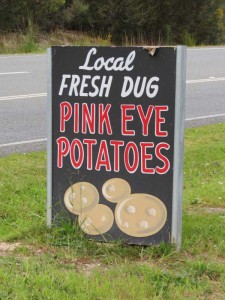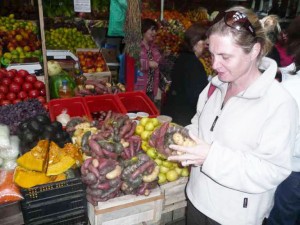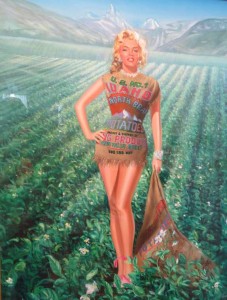Pink Eyes
/I was thinking about potatoes the other day. There's no accounting for the thoughts that race or dilly-dally their way through my head. Something pops up and I've gotta deal with it.
 Why potatoes? Well, we were passing Meredith's Fruit and Veggie store and I saw a huge sign announcing they had Pink Eyes on sale. Have you heard of Pink Eyes before? It's another name for conjunctivitis, I know, but I figured this Pink Eye had to be a fruit or veggie, so that narrowed it down some. We didn't have time to stop, so I made a mental note (very risky) to research this a bit more. A few more miles up the road, Ye Olde Oyster Cove Store announced Pink Eye availability, too. But their sign was a bit more specific: Fresh Dug Pink Eye Potatoes. Aha...now we were getting somewhere.
Why potatoes? Well, we were passing Meredith's Fruit and Veggie store and I saw a huge sign announcing they had Pink Eyes on sale. Have you heard of Pink Eyes before? It's another name for conjunctivitis, I know, but I figured this Pink Eye had to be a fruit or veggie, so that narrowed it down some. We didn't have time to stop, so I made a mental note (very risky) to research this a bit more. A few more miles up the road, Ye Olde Oyster Cove Store announced Pink Eye availability, too. But their sign was a bit more specific: Fresh Dug Pink Eye Potatoes. Aha...now we were getting somewhere.
We stopped. Not only did they have Pink Eyes, but they had Moonlight Brushed, Nicola, Dutch Creams and Red Rascals. Potato heaven! I had to stop to think of the last time I experienced such potato nervana. It certainly wasn't the South Pacific with their small, soft, gnarly spuds sitting in bug-infested dirty bins.  It was at a fresh market on the island of Chiloé in Chile. I remember being absolutely astounded at the variety of sizes, shapes and colors of potatoes that were for sale...orange, yellow, white, green, even bright purple. I stopped and took photos and the locals looked at me oddly for taking the time to photograph something so common.
It was at a fresh market on the island of Chiloé in Chile. I remember being absolutely astounded at the variety of sizes, shapes and colors of potatoes that were for sale...orange, yellow, white, green, even bright purple. I stopped and took photos and the locals looked at me oddly for taking the time to photograph something so common.
Potatoes were actually first cultivated in Peru around the same time the locals there domesticated the llama. The Incas grew potatoes and made a flour-like substance comparable to wheat flour for bread-making. The Spanish explorers brought the first potatoes back to continental Europe in the mid-16th century, just in time for the Poles to start cultivating them for use in making potato vodka. English explorers brought white potatoes back around the same time and introduced them to Ireland and Scotland. They had a hard time being accepted though. The Brits considered them dirty, evil and poisonous. They even started a society to disclaim these ugly tubers: Society for the Prevention of Unwholesome Diets, aka SPUD. It wasn't until the Irish starting immigrating to the States and growing them back in the 1700's that Americans explored the wonders of the white potato and they became a popular starchy vegetable. I still don't remember seeing any purple ones in the US though.
 On our trip back to the States last summer, we stopped in Blackfoot, Idaho at the Potato Museum. Here the mighty potato is revered. We saw all things potato including potato lotion, couch potatoes, potato chips and plush stuffed potatoes...even Marilyn Monroe modeling a potato sack in a potato field.
On our trip back to the States last summer, we stopped in Blackfoot, Idaho at the Potato Museum. Here the mighty potato is revered. We saw all things potato including potato lotion, couch potatoes, potato chips and plush stuffed potatoes...even Marilyn Monroe modeling a potato sack in a potato field.
All this just to say, we now know what Pink Eyes in Australia are. See how my mind wanders.





